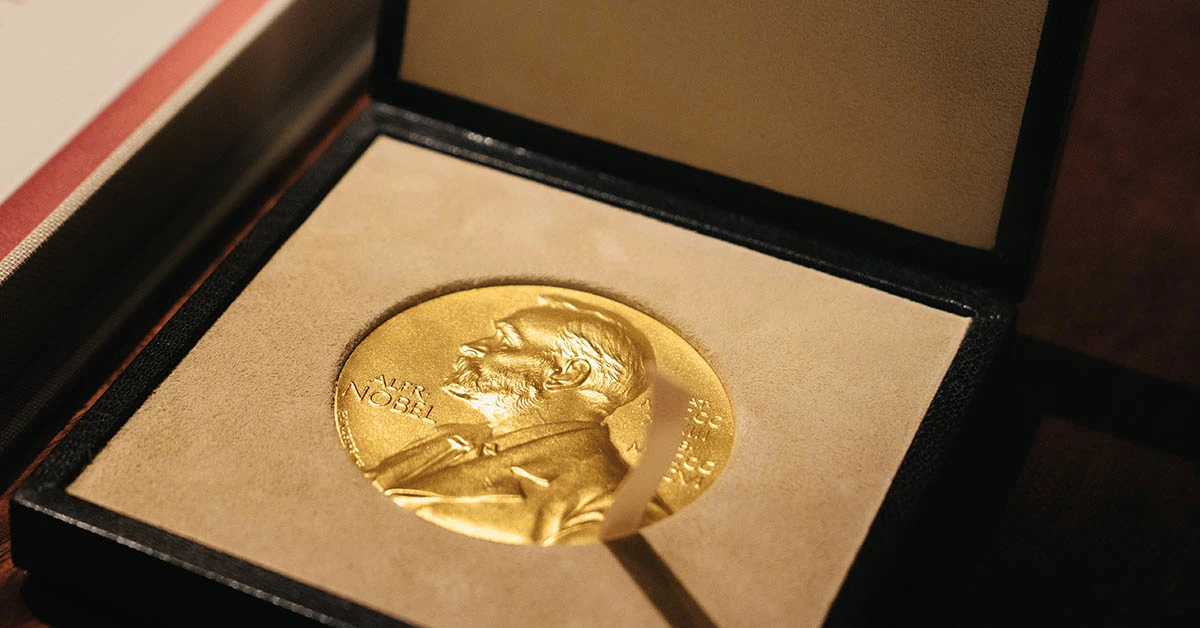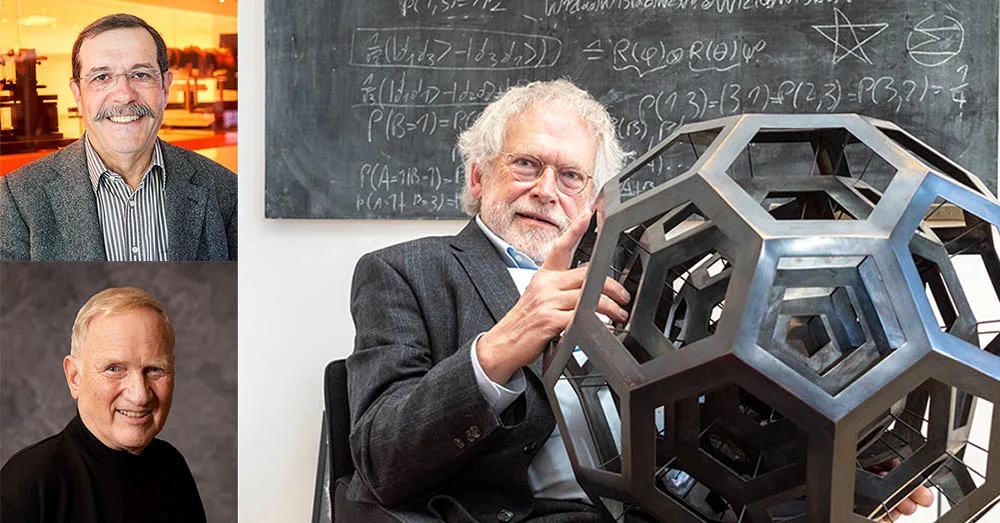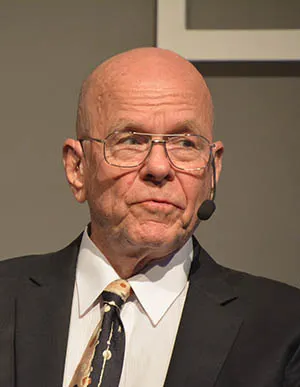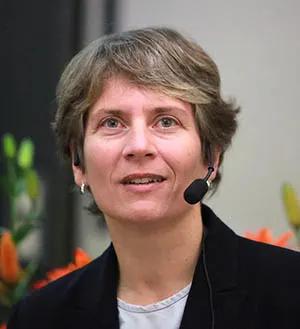Honoring the 2022 Nobel Laureates with free access to their research
October 10, 2022
By Alison Bert, DMA, Ian Evans

Read the Nobel Prize winners’ most cited papers published by Elsevier
Pictured above: The medals and diplomas are prepared and packed at the Nobel Foundation to be sent to the home countries of the Nobel laureates. (© Nobel Prize Outreach. Photo: Clément Morin)
Editor's note: This article will be continually updated with information about the newly announced Nobel Prize winners and access to their research.
Ask people to picture a scientist, and many will imagine a lone genius tinkering in a lab until that "Eureka!" moment arrives. The reality, of course, is that science is rarely done in isolation. Groundbreaking discoveries often stem from countless hours of work conducted across borders and decades. Even "unrelated" research and those "failed" experiments can play a key role.
It is in this realm that genius can emerge: in building on the knowledge of scientists who came before us — and questioning their conclusions. In applying seemingly disparate knowledge from other fields. In relating observations from our daily lives.
And just as researchers may draw their inspiration from far afield, their discoveries can improve the lives of people in unexpected ways. Alfred Nobel — himself a scientist, inventor and entrepreneur — understood the power of science to transform the world. In his will, he specified that the Nobel Prize go to those who "shall have conferred the greatest benefit to humankind."
As society continues to face massive challenges, we turn to science for solutions. And ultimately, each breakthrough is enabled by a community of researchers, co-authors, reviewers, editors and publishers. At Elsevier, we're proud to highlight that most of the Nobel Laureates in science and economics have published in our journals and books — 215 out of 216 since the year 2000, according to a Scopus analysis — and some have also served as editors, editorial board members or reviewers.
We consider it a privilege to help support the research community. Many of our people began their careers in science or medicine, and they are passionate about working closely with colleagues in the field so researchers around the world can find their work and build on it.
To honor this year’s Nobel Laureates and the community that made their breakthroughs possible, we are bringing together a selection of their most cited papers published with Elsevier.
Their work will, in turn, empower today’s scientists to make further discoveries.
Nobel Prize in Physiology or Medicine
The 2022 Nobel Prize in Physiology or Medicine was awarded to Svante Pääbo "for his discoveries concerning the genomes of extinct hominins and human evolution."
Pääbo’s seminal research gave rise to an entirely new scientific discipline: paleogenomics. By revealing genetic differences that distinguish all living humans from extinct hominins, his discoveries provide the basis for exploring what makes us uniquely human.

Svante Pääbo (Photo by Duncan Hull CC BY-SA 4.0)
Selected research by Svante Pääbo
Cell
The Predecessors Within ... (2018)
Stem Cell Reports
Current Biology

Alain Aspect (top left), John Clauser (lower left) and Anton Zeilinger. (Photo of Aspect via Ecole polytechnique Université Paris-Saclay, CC BY-SA 2.0; Photo of Clauser via John Clauser, CC BY-SA 4.0; photo of Zeilinger by Jaqueline Godany, CC BY-SA 4.0)
Nobel Prize in Physics
The Nobel Prize for Physics was awarded to Alain Aspect, John F Clauser and Anton Zeilinger "for experiments with entangled photons, establishing the violation of Bell inequalities and pioneering quantum information science." John Clauser developed John Bell’s ideas, leading to a practical experiment. When he took the measurements, they supported quantum mechanics by clearly violating a Bell inequality. This means that quantum mechanics cannot be replaced by a theory that uses hidden variables.
Some loopholes remained after John Clauser’s experiment. Alain Aspect developed the setup, using it in a way that closed an important loophole. He was able to switch the measurement settings after an entangled pair had left its source, so the setting that existed when they were emitted could not affect the result.
Using refined tools and long series of experiments, Anton Zeilinger started to use entangled quantum states. Among other things, his research group has demonstrated a phenomenon called quantum teleportation, which makes it possible to move a quantum state from one particle to one at a distance.
Selected research by the 2022 Nobel Laureates in Physics
John Clauser
Atom Interferometry
Physica B+C
Alain Aspect
Comptes Rendus Physique
The birth of wave mechanics (1923-1926) (2017)
Optics Communications
Physics Letters A
Anton Zeilinger
Atom Interferometry
Physics Letters A
Physica B+C
Optics Communications
Nobel Prize in Chemistry
The Nobel Prize in Chemistry was awarded to Carolyn R Bertozzi, Morten Meldal and K Barry Sharpless “for the development of click chemistry and bioorthogonal chemistry.”
Barry Sharpless becomes the fifth individual to be awarded two Nobel Prizes, following in the footsteps of John Bardeen, Marie Skłodowska Curie, Linus Pauling and Frederick Sanger.
Carolyn Bertozzi is the eighth woman to be awarded the Nobel Prize in Chemistry, the first being Curie in 1911.
Sharpless coined the concept of click chemistry around the year 2000 — a form of simple and reliable chemistry where reactions occur quickly and unwanted byproducts are avoided.

Barry Sharpless is the fifth individual to be awareded two Nobel Prizes. (Photo by Bengt Oberger, CC BY-SA 4.0)
Shortly afterwards, Morten Meldal and Sharpless — independently of each other — presented what is now the crown jewel of click chemistry: the copper catalysed azide-alkyne cycloaddition. This is an elegant and efficient chemical reaction that is now in widespread use. Among many other applications, it is used in the development of pharmaceuticals for mapping DNA and creating materials that are more fit for purpose.
Carolyn Bertozzi took click chemistry to a new level. To map important but elusive biomolecules on the surface of cells — glycans — she developed click reactions that work inside living organisms. Her bioorthogonal reactions take place without disrupting the normal chemistry of the cell.

Carolyn Bertozzi is the eighth woman to be awareded a Nobel Prize in Chemistry. (Photo by Armin Kübelbeck CC BY-SA 3.0)
Selected research by the 2022 Nobel Laureates in Chemistry
Carolyn R. Bertozzi
Cell
Cell Chemical Biology
Cell Reports
Current Biology
iScience
Journal of Lipid Research
Molecular Cell
Morten Meldal
Bioorganic & Medicinal Chemistry Letters
Organic & Biomolecular Chemistry
K Barry Sharpless
International Journal of Infectious Diseases
Journal of Biological Chemistry
Sveriges Riksbank Prize in Economic Sciences
The Sveriges Riksbank Prize in Economic Sciences was awarded to Ben Bernanke, Douglas Diamond and Philip Dybvig for significantly improving our understanding of the role of banks in the economy, particularly during financial crises.
For an economy to function, savings must be channeled to investments. However whereas savers want instant access to their money to cover unexpected outlays, businesses and homeowners need to know they will not be forced to repay their loans prematurely. Philip Dybvig and Douglas Diamond showed how banks can solve this problem by acting as intermediaries. They can accept deposits from many savers, banks can allow depositors to access their money when they wish, while also offering long-term loans to borrowers.
Diamond also showed how banks served as intermediaries between many savers and borrowers, being better suited to assessing borrowers’ creditworthiness and ensuring that loans are used for good investments.
Ben Bernanke analyzed the Great Depression of the 1930s, the worst economic crisis in modern history. Among other things, he showed how bank runs were a decisive factor in the crisis becoming so deep and prolonged.
Interviews with an Economics Laureate and Nobel committee member
Listen to a telephone interview with Douglas Diamond and an interview with John Hassler, member of the Nobel committee for the economics prize.
Telephone interview of Douglas W. Diamond
"We can learn how important it is to make sure that this system doesn't collapse."
Selected research by the 2022 Nobel Laureates in Economics
Ben Bernanke
Journal of Monetary Economics
Carnegie-Rochester Conference Series on Public Policy
Douglas Diamond
Journal of Financial Economics
Carnegie-Rochester Conference Series on Public Policy
Philip Dybvig
Journal of Economic Theory
Economics Letters
Journal of Financial Economics
Contributors
Elsevier employs over 8,100 people around the world, many beginning their careers in research or healthcare. This year’s coverage would not have been possible without the contributions of the following Elsevier colleagues:
Amsterdam: Tim Horscroft, Matthanja Muller, Maha Rhannam, Celine Richard, Rob van Dalen, Donna Weerd-Wilson
Cambridge, Massachusetts: Helene Hodak, Sana Nambiar, Takmela Rahman, Abby Sonnenfeldt
Chennai, India: Anburaj Thangaraj
Melbourne: Catherine Carnovale
New York: Alison Bert
Oxford, UK: Ian Evans, Alan Crompton, Marta Meazza, Leanne Mullen, Shamus O’Reilly, Jessica Pancholi, Rachel Shaw, Victoria Wetherell
Paris: Deborah Logan
Also, much of this information came from the Nobel Prize website.
Contributors

